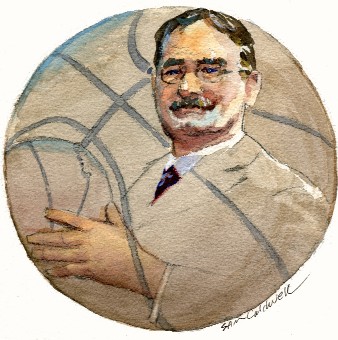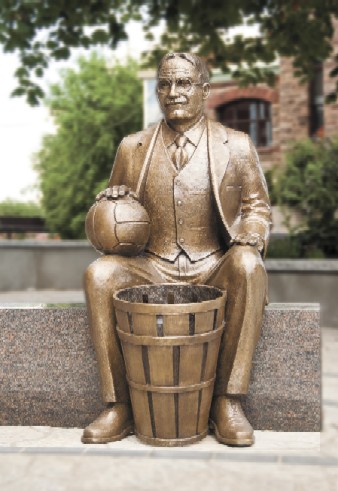Born in Ramsay Township (in Lanark County in Eastern Ontario, just west of the City of Ottawa) on 6 Nov 1861, James was the eldest son of Scottish immigrants John and Margaret Naismith. In 1869, the family moved to Grand Calumet where his father began work as a saw hand. He was orphaned at age nine, when his parents contracted typhoid fever while working in the milling community. When their grandmother died in 1872, the Naismith children, Annie, James and Robbie, were left under the care of their uncle, Peter Young, back in Ramsay. James attended the one-room schoolhouse in Bennies’ Corners. He was known in the neighbourhood as a strong and skillful boy, but at school his monthly report cards showed poor grades. Although not the head of his class in academics, he was a leader among his peers in all physical activities and showed signs of becoming a fine athlete. James attended high school in Almonte, ON.
Despite the burden of farm duties, there was also time for play. In Bennies’ Corners, the local blacksmith shop was the gathering spot for the children. Here they enjoyed watching the blacksmith work his materials and playing in the sugarbush behind the shop. Where a tree or boulder served as a convenient base, they played variations of tag and hide-and-seek or tried their skill at Duck on the Rock - a game which combined throwing with tag using a large base stone to be guarded by the one player. This stone sat in the blacksmith’s yard adjacent to the Bennies’ Corners school. Players formed a line from a distance of 15-20 feet from the base stone. Each player used a fist-sized stone. The object was to dislodge the “guards” stone from the top of the base stone, by throwing and taking turns.
After graduating from Almonte High School, he attended McGill University. Jim headed for McGill’s gymnasium where he soon began participating in the gymnastic and rugby program. By his junior year, he was winning the university’s highest honours for his athletic involvement. Jim had time for extracurricular interests, joining the student government and Literary Society for which he debated. In 1887, he was cited on the Prize and Honour List for having passed the Bachelor of Arts in Honours in philosophy and Hebrew. He graduated as one of the top ten in his class on 30 Apr 1887. After graduation, Jim enrolled in the largest theological school affiliated with McGill University, the Presbyterian College. To finance his education, he accepted an appointment as instructor of physical education in the gymnasium at McGill. Although James won theological scholarships, he dismayed colleagues and professors by continuing his involvement in athletics. Naismith learned of the YMCA International Training School in Springfield, MA, for the education of laymen-leaders of youth. Shortly thereafter, in the summer of 1890, Jim left the Presbyterian College as an non-ordained minister to pursue a career with an emphasis on physical education. Remembering Duck on a Rock and how successful the lobbed arcing shot proved, Naismith incorporated a set of rules for throwing a soccer ball aimed at two peach baskets, thus creating a new game of his design called “Basket Ball”. That was in 1891. Within a few years, this game caught on and was soon being played at other institutions.
Naismith then embarked on a career in Physical Education through the YMCA, but took time out to earn his Medical Degree in 1989 while operating the Denver YMCA. This led him to accept the positions of Physical Education Director, Campus Chaplain and Basketball Coach at the University of Kansas. He remained there from 1898 until his retirement in 1938. He served twice in military conflict, including WWI in France. From time to time, Naismith returned to visit the area of his boyhood in Ramsay and Almonte, and maintained a long friendship with another famous “Ramsay son”, Tait McKenzie. Naismith saw his gift of basketball admitted as an official sport at the 1936 Berlin Olympics, which he felt was the highlight of his long career.
He died in Lawrence, KS, from heart trouble on 29 Nov 1939.
This article was taken from The Souvenir Program of the North Lanark Highland Games, Almonte, ON, 20 Aug 2011

Dr. James Naismith, a Canadian Scot, invented the game of basketball. It was first played December 21, 1891 in Springfield, Massachusetts.
In this painting by a Texas Scot, Sam Caldwell, Naismith has a mischievous grin, as though knowing the pleasure the game would bring to the world. Among many other honors, Caldwell was named Texas State Artist for 2004. The Naismith painting joins three other notable Scot portraits by Caldwell: King Robert The Bruce, Robert Burns and Sir Walter Scott. Those images, and many other Caldwell works can be viewed at www.samcaldwell.com.
This watercolor painting may be enlarged for use in library exhibits and other venues. A large oil painting of Dr. Naismith will be available in November.
For information on obtaining additional copies, or prices regarding the purchase of reproductions suitable for framing, email
Vizi Lange, or call: 832-661-7540.
The Caledonian Foundation USA, Inc
The USA members of CASSOC, Dr. Robert J. Munro and Miss Duncan MacDonald, trustees of The Caledonian Foundation USA, Inc., have informed us that the foundation is celebrating its 35th Anniversary this year and will continue with its exhibitions of Great Scots, with public libraries being the principal venue, remembering that this is also the Centenary of the Carnegie Corporation of New York and the thousands of free public libraries created by Andrew Carnegie.
A principal exhibit focuses on the life of James Naismith, a Canadian Scot, who was born 6 November 1861, and created the Game of Basketball, which was first played (anywhere in the world) on 21 December 1891.
Information on this unusual man has been provided to the member-organizations comprising The Scottish Coalition USA, with the possibility of reaching over 300,000 individual members of these organizations. It is emphasized that these are not US Census figures but reflect persons who pay dues to these organizations, meaning that they are committed to Scottish-American interest.
In addition to materials furnished to these groups for possible use in their newsletters, a brief biography of Naismith is on the Caledonian website: www.caledonianfoundationusa.org. It is recommended that the comprehensive website of the www.NaismithMuseum.com be used as a principal reference.
A major contribution to this project is the creation of a watercolor painting of Naismith by Sam Caldwell, who was named Texas State Artist for 2004, in addition to other acknowledgements of his talent. Information on obtaining copies of the portrait is available from the artist:
Email Sam Caldwell
The media is being approached at the national and local level. The diversity of coverage is perhaps best indicated by mention of a local television show on Martha’s Vineyard, MA. Host of the program is Robert Tankard, a well-known TV personality and former teacher at the MV Regional High School, who interviewed Sam Barnes, a retired US Navy captain, who is known for his drawings of historic structures in New England.
The program has been aired on MVTV and will have numerous repeat showings in the months ahead. There is additional interest in the subject due to the fact that James Naismith visited Martha’s Vineyard in the Summer of 1891 to study the principles of the Swedish system of exercise being taught there by Baron Nils Posse, a Swedish professor who was lecturing that summer at the Martha’s Vineyard Summer Institutes.
It is of considerable interest that the information on this visit was obtained from the archives of the Martha’s Vineyard Museum, formerly known as the Dukes County Historical Society.
From: The Caledonian Foundation USA, Inc
Miss Duncan MacDonald,
17 Oct 2011


